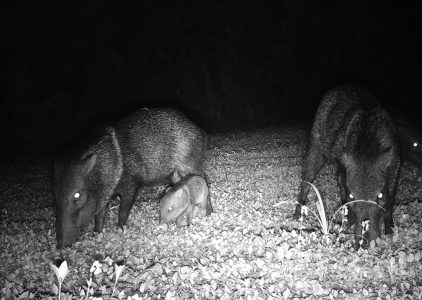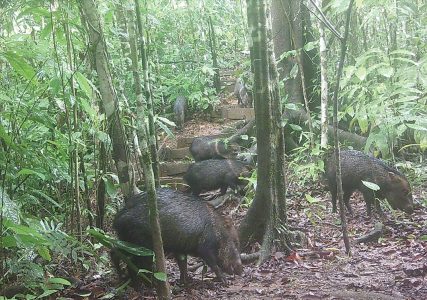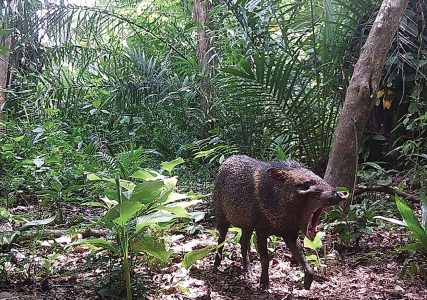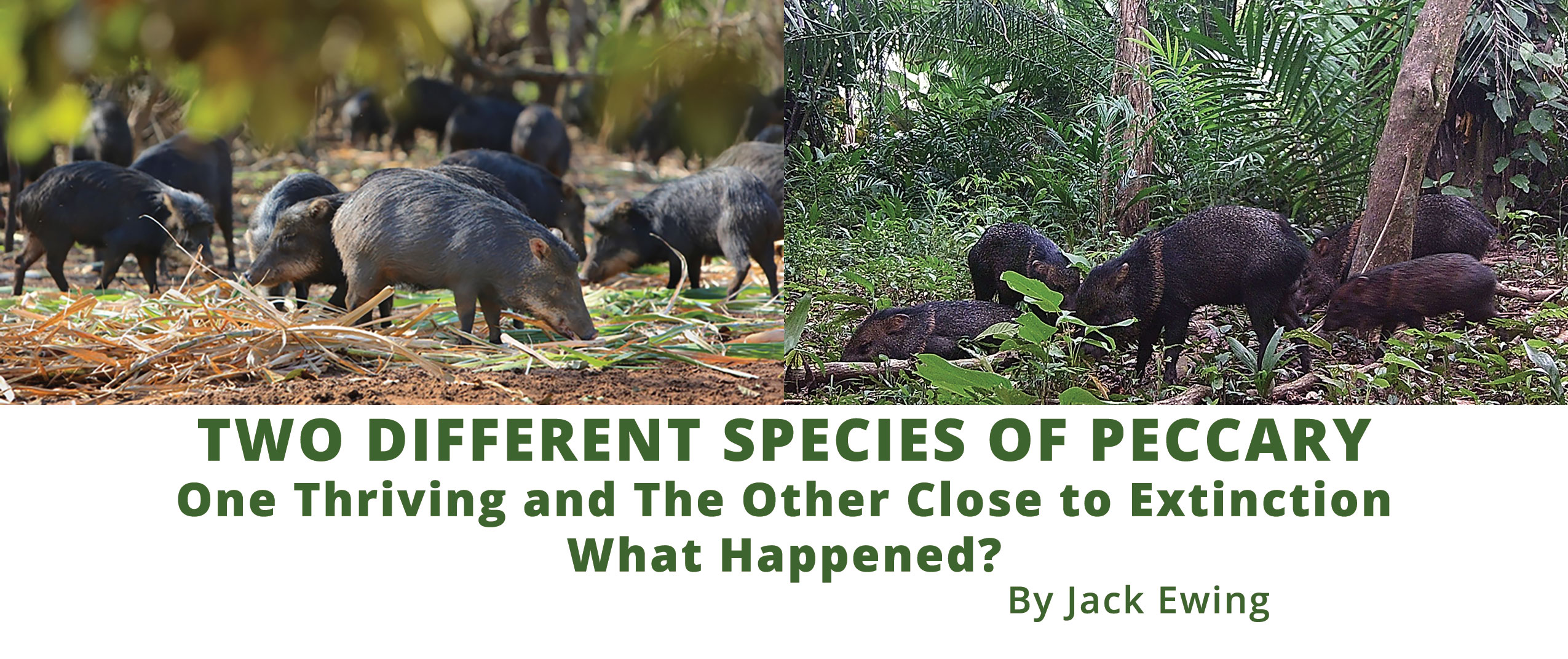Two Different Species of Peccary
 One century ago, White-lipped Peccary were plentiful in the area along the Pacific coast south of Quepos. Also abundant was a closely related species, the Collared Peccary. Today the white-lipped peccary is locally extinct in most of Costa Rica. A few small herds can be found in several isolated, large primary forests in different parts of the country.
One century ago, White-lipped Peccary were plentiful in the area along the Pacific coast south of Quepos. Also abundant was a closely related species, the Collared Peccary. Today the white-lipped peccary is locally extinct in most of Costa Rica. A few small herds can be found in several isolated, large primary forests in different parts of the country.
A biologist friend of mine has been doing a study of large mammals in Costa Rica. He has placed about 80 trail cameras over much of the country in large expanses of primary forest. A trail camera is triggered by motion and infrared rays. It can be programmed to take photos or videos. His cameras have captured images of many seldom-seen species such as jaguars, pumas, tapirs, and even bush dogs. Strangely, during the 10 years since the study began, his cameras haven’t detected a single white-lipped peccary. None of his cameras are located along the Pacific coast south of Quepos. I have talked with many old-timers from this area, but only three had ever seen a white-lipped peccary. According to these three ex-hunters, the last time one was seen here was in the mid-1940s.
 In the coastal area south of the Savegre River we see Costa Rica’s other peccary species, the Collared Peccary, often. Their population has increased exponentially in the last 30 years. I came here to live in 1972, and the first time I saw a peccary was in the mid-1990s. Today they are commonly encountered on the trails, forest edges, wetlands, and secondary growth. Friends and neighbors report seeing them regularly, and those who farm complain about the damage they do to crops. Over the last 50 years this species has thrived. Let’s have a look at some of the differences between the two species, some of which may have influenced the drastic changes in their populations.
In the coastal area south of the Savegre River we see Costa Rica’s other peccary species, the Collared Peccary, often. Their population has increased exponentially in the last 30 years. I came here to live in 1972, and the first time I saw a peccary was in the mid-1990s. Today they are commonly encountered on the trails, forest edges, wetlands, and secondary growth. Friends and neighbors report seeing them regularly, and those who farm complain about the damage they do to crops. Over the last 50 years this species has thrived. Let’s have a look at some of the differences between the two species, some of which may have influenced the drastic changes in their populations.
The diets of both species are quite similar, fruit, seeds, leaves, tubers, and some animal protein, such as insects, worms, snails, and small vertebrates. Both can digest certain toxic plants that would be extremely harmful to other species of mammals. You can see from the photos that both resemble pigs. Like pigs, they do a lot of routing around in the ground.
 About 50 years ago I went with some friends on a boat trip and ended up in a place called Tortuguero. Today it is a national park and a tourist haven teaming with hotels. At the time of my first visit, there was one house. The lady of the house had three or four tables on her porch and would cook for passersby. There wasn’t a menu. Instead, customers were told what was being served that day, and you could take it or leave it. Our lunch consisted of rice, beans, and white-lipped peccary steak. Not knowing about the precarious status of the species, I ate the steak and must say that I enjoyed it. A decade later I ate some collared peccary steak. It tasted so bad that I couldn’t finish it. Later I learned that there are ways to prepare meat from these that will make it a little easier on the palate. Nevertheless, if both species are present in the same forest, hunters will pursue the tastier white-lipped peccary first.
About 50 years ago I went with some friends on a boat trip and ended up in a place called Tortuguero. Today it is a national park and a tourist haven teaming with hotels. At the time of my first visit, there was one house. The lady of the house had three or four tables on her porch and would cook for passersby. There wasn’t a menu. Instead, customers were told what was being served that day, and you could take it or leave it. Our lunch consisted of rice, beans, and white-lipped peccary steak. Not knowing about the precarious status of the species, I ate the steak and must say that I enjoyed it. A decade later I ate some collared peccary steak. It tasted so bad that I couldn’t finish it. Later I learned that there are ways to prepare meat from these that will make it a little easier on the palate. Nevertheless, if both species are present in the same forest, hunters will pursue the tastier white-lipped peccary first.
 The collared peccary travel in small groups, usually six to ten. I am told that there will occasionally be as many as 20. Hunters have a hard time following and killing animals in small groups. If a human startles a group of six peccaries, they will run in all different directions, and in a few seconds, there will be none in sight. The white-lipped species travel in herds of 50 to 100. When a hunter finds a group, and fires his first gunshot it is easy to kill several in the time it takes the rest of the herd to disperse.
The collared peccary travel in small groups, usually six to ten. I am told that there will occasionally be as many as 20. Hunters have a hard time following and killing animals in small groups. If a human startles a group of six peccaries, they will run in all different directions, and in a few seconds, there will be none in sight. The white-lipped species travel in herds of 50 to 100. When a hunter finds a group, and fires his first gunshot it is easy to kill several in the time it takes the rest of the herd to disperse.
At the beginning of the last century, settlers began deforesting this region and using the land for farming and cattle ranching. As the deforestation advanced, the parcels of forest diminished in area. By the 1940s there weren’t many forests large enough to support a herd of 50 peccary. The few white-lipped peccaries that remained migrated to larger, more isolated jungles. At the same time, the collared peccary got along fine in the smaller parcels of rainforest.
I’m sure there are more reasons for the remarkable differences in population between the two species, but these are the primary ones.
One interesting bit of trivia about the collared peccary is that in northern Mexico and the southwestern United States people call it the javelina even though it is exactly the same species. The origin of the name javelina is that a peccary fang is shaped like a javelin. Javelinas are reputed to be very aggressive. The truth is, they are no more dangerous than the collared peccary we have in Costa Rica, and I have never seen one of them act aggressively.
Jack Ewing was born and educated in Colorado. In 1970 he and his wife Diane moved to the jungles of Costa Rica where they raised two children, Natalie and Chris. A newfound fascination with the rainforest was responsible for his transformation from cattle rancher into environmentalist and naturalist. His many years of living in the rainforest have rendered a multitude of personal experiences, many of which are recounted in his published collections of essays, Monkeys are Made of Chocolate & Where Jaguars & Tapirs Once Roamed. His latest book is, Monkeys are Made of Mangos.

